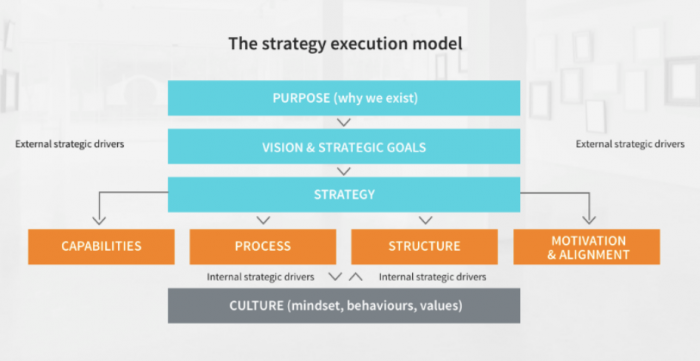Blog: Culture’s Role In Your Business Strategy
Published: 4th February, 2018
Author: Rob Shorrick, CEO at The Leadership Gallery
The culture of your business is often front-of-mind if you’re a senior leader; however, it remains a challenge to understand how to effectively influence it.
Good culture is a key pillar of business success; it allows strategy to remain relatable to staff and espouses a set of behaviours for those working within the business.
It’s understandable, then, that boards wish to know whether their organisational culture is fit for purpose, and many may even have identified specific areas that they wish to change. However, attempts to affect culture in isolation will often fail to be effective. Culture is the result of many contributory factors, and therefore, business leaders should view it as an ‘output’ of those factors.
Understanding the Contributory factors
Vision and purpose
A key task for business leaders is maintaining a clear view of the vision, purpose, ethics, values and degree of individual empowerment they wish to see within their organisations when making decisions. If you’re a senior decision maker, consider whether you are able to:
- Articulate the ‘strategic purpose’ of your organisation; that is, “why do we do what we do?”
- Obtain a clear and ongoing view of customer outcomes within your firm, as well as the commercials
- Articulate how your firm’s strategy ensures the delivery of good customer outcomes
Business leaders’ open endorsement of their firm’s clearly defined vision and purpose can have far-reaching effects; their promotion of the customer-centric approach they wish the firm to take will proliferate downwards, helping to ensure cultural success.
Strategy and strategic goals
How strategy contributes to overall culture can be broadly categorised into two areas:
- Commerciality – the need to be commercially efficient; the strategic decisions made in the interest of commerciality
- Customer-centricity – the need to deliver the right customer/client experience; strategic decisions made for the benefit of the end user
How you balance these factors in your organisation affects the resultant culture. Viewing culture through these lenses, and understanding that many strategic decisions effect the balance between them, will aid thinking in this area. For example, do production or sales targets encourage the right behaviours in order to achieve commercial success while ensuring customers get the best possible experience?
Capabilities
Whether you have the capabilities within the business to achieve your aims will influence overall culture. Strategic goals which are misaligned to staff skillsets can put pressure on a firm’s culture, and changes in strategic direction often necessitate the changing of strategic goals. For this reason, it is vital to assess and obtain the capabilities for success before embarking on significant change projects. Taking the right approach in this area will allow a firm’s good culture to stay intact.
Structure
Similarly, setting the business structure up correctly is vital for ongoing cultural success – everything from the location/proximity of teams to whether reporting lines are appropriate and allow effective collaboration should be considered. Imminent change can be a chance to assess and realign business structure, and if approached correctly, will enhance culture.
Process
Robust yet intuitive processes have a galvanising effect on culture; enabling business, allowing staff to deliver on their personal objectives and helping all those within the company to feel ‘bought in’ to the business’s purpose. Inversely, over time, and through the addition of new products, services, departments or business objectives, processes can become over-engineered and impractical, and this can erode the way staff see the business (as well as the potential effects on commerciality).
Motivation and alignment
Motivation and alignment comprises four essential components that can support strategy. Senior managers should ensure that:
- All employees understand their roles in detail
- The relationship between the employee and their line manager is actively nurtured and effective
- Each employee has absolute clarity on their own level of accountability
- All employees understand the purpose, the vision and the strategy of the business

The alignment between role and strategy, when set up correctly, gives the organisation absolute clarity and a better chance of success. When this doesn’t happen, Individuals and departments can move in different directions, and valued company goals and targets can be affected.
Cultural success is the result
By seeking to understand the unique ways these issues affect their business, leaders will be able to more clearly understand and address the drivers of culture in order to influence it.
In some cases, this may require a mindset change – from initiatives designed to tackle culture head-on, to a more holistic approach that embraces all of the contributing factors.